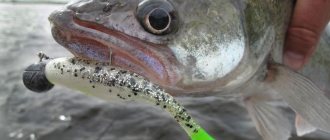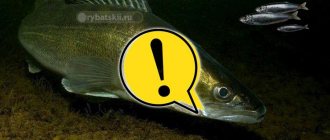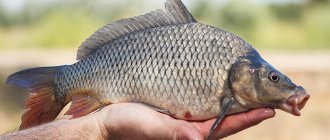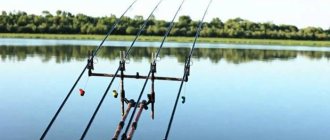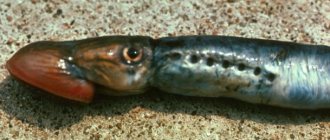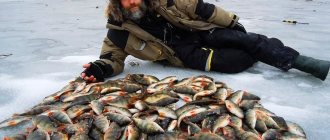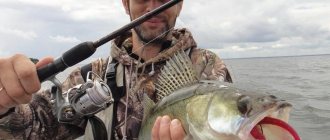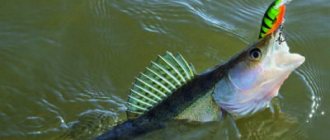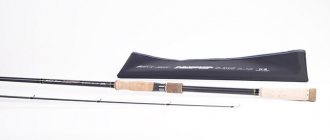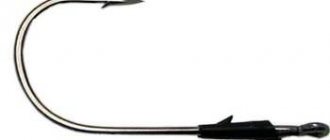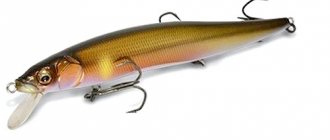Throughout the year, the behavior of pike perch is varied:
- In the spring , when the ice melts, the pike perch gradually comes to life. The behavior and location of the fanged predator during this period is dictated by awakening from winter, pre-spawning feast and spawning. Pike perch are active, especially during the spring run, but they are not easy to find. Catching pike perch on a donk in the spring is most promising at a depth of 2-6 meters on edges, dumps, places next to snags, at the boundaries of different currents.
- In summer, the behavior of pike perch is predictable, and therefore fishing is more productive. During the day, fishing for pike perch on a donka is carried out in promising spring places, and at night you need to hunt this predator on sand spits.
- Autumn fishing is the most productive - the activity of the fanged predator intensifies, like other predators. In September, you can still catch pike perch at night on spits, but in October, promising places begin to move to pools, in the vicinity of which you need to cast donks.
Tackle and its equipment
Donka for pike perch is a delicate tackle compared to tackle for other predators. Of course, our great-grandfathers used the most primitive donka, made with their own hands, without the use of rods and reels, to catch predators. But today there are feeder or spinning rods, which are the basis of modern donkey fishing. Due to its length, such tackle allows you to cast the rig far and, when fishing, tear the predator off the bottom. Casting is easy and convenient, and the slightest touch to the bait is immediately signaled by the tip of the rod.
For bottom tackle for pike perch, you need a rod 3.6-3.9 meters long, which is equipped with a spinning reel with a 4000-unit spool. For the base of the rig, the best option would be braid with a diameter of about 1.5# (0.2 mm). It is better to take a sliding sinker - when biting, the fanged predator will not feel the resistance of the tackle and will not throw away the bait. The second option that can be used is equipment with an anti-twist. An installation made in this way is sensitive, does not alarm the predator and will not allow the baitfish to twist the equipment around the main fishing line if fishing is carried out in the current.
The optimal leash would be a fluorocarbon version with a diameter of 0.3-0.4 mm and a length of about 70 cm. The size of the hooks with which the leash is equipped depends on the size of the baitfish. When the bait size is about 10 cm, the leash is equipped with a hook No. 4-2 (No. 8-9 according to Russian numbering) and a double No. 8.
equip the forest-like leash with a float, which can serve as a piece of wine cork. This is necessary so that live fish do not lie at the bottom. The issue of equipping a donkey with a metal leash has always been and will remain controversial. Of course, pike can hunt next to pike perch, but when equipped with a leash from pike teeth, the likelihood of a pike perch biting decreases significantly. Therefore, true zander fishermen do not use metal leashes, and practical and prudent fishermen include a steel leash in their gear.
Secrets and methods of catching pike perch
Before considering the secrets of catching pike perch, it is worth spending a few words on the pike perch itself and the peculiarities of its behavior. Without this knowledge, it will be impossible to properly plan your fishing trip and choose the most appropriate fishing tactics.
First, let's look at the habitats of pike perch. We are not interested in small low-flow lakes with silted bottoms, since pike perch cannot live in such reservoirs. The ideal habitat for pike perch is a deep, mid-latitude river with moderate currents and complex bottom topography. The relatively warm waters of such rivers provide pike perch with a sufficient amount of food, and the presence of a current has a beneficial effect on the oxygen regime, to which pike perch is so sensitive.
When choosing a place for catching pike perch, special attention should be paid to exits from channel holes and areas near hydraulic structures located at great depths. In both cases, there should be at least a slight current in the selected areas. Also very promising are areas along channel dumps, deep-water “tables” with heterogeneous terrain and a rocky or clay-rocky bottom, holes below riffles and sections of the river below dams. When analyzing these theoretically promising areas, we can conclude that they are all united by three factors: depth, heterogeneous bottom structure and the presence of current. Based on this, a section of a reservoir in which all of the above components are expressed to one degree or another can be considered potentially catchable, even if it was not described above.
The only exception concerns fishing for pike perch at night. At night, pike perch often goes out to feed in shallow coastal areas of the reservoir, or at least to depths shallower than those at which it fed during daylight hours.
But the secrets of catching pike perch don’t end there. I consider it necessary to dwell on the feeding characteristics, or rather the structure of the pike perch’s mouth. The pike perch's mouth is designed in such a way that it can only swallow relatively narrow prey. Ignorance of these features can cause low fishing results when catching pike perch using live bait with a wide body (crucian carp, silver bream, etc.) or using wide spoons or wobblers.
Having learned a little about the peculiarities of the life and behavior of pike perch, you can proceed directly to considering the methods and tactics of catching this predator. The main methods of catching pike perch are spinning, trolling, side fishing and bottom fishing. Fishing with mugs was widely used in the past, but currently the number of fans of this type of fishing has decreased significantly.
Spinning fishing is the most accessible and versatile, which is why it has won the largest number of fans. Spinning allows you to fish with equal success both local promising areas near various types of obstacles and wide expanses of deep reaches. Of course, depending on the situation, spinning fishing can be done both from a boat and from the shore.
The most common artificial baits for catching pike perch using a spinning rod are various types of silicone baits and wobblers. Somewhat less commonly used are foam fish, which, although they do not have their own game, have proven themselves well on active fishing, in which the angler himself sets the game for the bait. It should be remembered that regardless of the type, baits must be narrow-bodied.
The simplest equipment for catching pike perch with a spinning rod is mounted on a jig head or on a “eared” sinker. Carolina, Texas and rigs with a side leash are somewhat more difficult to install, but with some experience they will not cause any difficulties for the angler.
It is worth noting that when specifically fishing for pike perch, steel leashes are not used. Pike-perch does not interrupt the leads like pike, so there is no need to unnecessarily coarse the tackle.
Catching pike perch by trolling, although not as widespread as spinning fishing, is becoming more and more popular every year, especially in trophy fishing. When fishing by trolling, mostly sinking wobblers are used. The peculiarity of trolling is that the distance of the bait is practically unlimited, which allows you to bring the wobbler to the working depth without losing the effective range of the bait. This becomes especially relevant when fishing at great depths, when spinning fishing for pike perch using wobblers becomes ineffective or impossible at all.
Side rods are used when fishing from a boat in areas with weak currents. During the fishing process, the boat slowly floats downstream or drifts under the influence of the wind current. In the second case, the speed of the boat can be reduced, if necessary, by using a floating anchor. Such an anchor is a small parachute immersed in water to a meter depth. The size of the anchor itself depends on the sail of the vessel and the strength of the wind.
Using an onboard fishing rod allows you to fish in the bottom layer with precise contouring of the bottom topography. This, of course, cannot but affect the success of fishing, which is also accompanied by the high sensitivity of the gear. It is only worth noting that onboard fishing rods are of little use for searching for active feeding fish and can bring guaranteed success only when fishing in a previously studied area of the reservoir. The same promising place can be fished several times, each time rising from the lowest point to the beginning of the site using oars or a motor.
When fishing with onboard fishing rods, soft silicone baits, live bait or pieces of fish can be used on jig heads. Catching pike perch with live bait or a piece of fish in this case will be preferable. Natural baits in most cases give better results than artificial ones, and the short fishing range, which is determined solely by the depth under the boat, allows you to quickly refresh the bait.
Fishing with side rods is carried out at depths of three meters or more. In muddy water, the fishing depth can be reduced somewhat, but here you will have to take into account natural light, since the shadow from the boat can alert the pike perch.
Catching pike perch on donkeys is carried out mainly in the dark, when the use of other fishing methods is difficult or impossible. At the same time, this type of fishing should not be underestimated - many anglers catch pike perch exclusively on donkeys, and quite successfully.
Catching pike perch from the shore is often complicated by the large casting distance required, but with the help of donks mounted on powerful spinning rods, this issue becomes completely solvable.
When fishing with donkeys, live bait, dead fish or pieces of fish are used. If it was not possible to prepare fresh bait, you can use frozen sprat. The only requirement is that the sprat must be frozen only once! Thawed and re-frozen fish meat becomes loose and does not stick well to the hook. In addition to this, with repeated freezing, a lot of juice is lost, and the sprat becomes less attractive to pike perch.
Lures and live baits
The undoubted advantage of donkey is the presence of live bait, which moves and has a real smell. The size of the bait can vary from 6 to 12 cm. In spring and when pike perch is deeply passive, it is advisable to use live bait of the minimum size. Fishing for predatory fish in late autumn, when all types of fish, including fanged ones, move closer to the pools, involves the use of large live bait.
Nature has endowed pike perch with a small mouth - hence its preference for narrow fish species. The most common food for pike perch is bleak. Its disadvantage is that it quickly falls asleep on the hook. Excellent live bait options that are more difficult to obtain are goby and gudgeon.
They live on the hook for a long time and are a good treat for pike perch. Another species of live bait that a fanged predator cannot resist is the spined lance. This fish lives on a hook for a very long time and moves actively, so in many reservoirs where this fish is found, it is the number one baitfish for pike perch.
The most reliable way to attach live bait to pike perch is to attach it at two points - the double hook is threaded through the operculum and comes out of the mouth with hooks, and the single hook is hooked in the dorsal fin area.
Live fish are ideal bait for the fanged predator, since this is the food it constantly feeds on. But sometimes it is not possible to catch live bait, but it is known that pike perch feeds in a certain place and at a certain time. In such a situation, this predator can be offered other bait: a small frog, a bunch of worms or crawlers, meat from a toothless shell.
Search and selection of location
Regardless of the seasons of the year, pike perch have favorite stopping places. They can be determined based on knowledge of the bottom topography. This bottom predator loves to track prey on the boundaries of dumps in the depths, on strong currents, picking up fish that have weakened from the resistance of the water. For installing docks, smoother transitions of the shallows to significant depths are one of the convenient, promising options.
Flat bottom plateaus with strong currents and significant depths are also sites for fanged flocks. A guide to promising places for pike perch fishing can be provided by avid bream fishermen, who constantly fish for bream and know the routes of its movement. Undoubtedly, pike perch also moves with these schools. Steep banks with fast whirlpools and reverse currents are of interest to pike perch hunters on the borders of these anomalies. Casting to such promising points promises the capture of significant trophies.
Pike perch, sensitive to the presence of oxygen in water, does not like stagnant places in reservoirs and prefers to stay in the water areas of the confluence of river streams and places with underwater springs. The boundaries of dead wood debris and underwater cramps are also promising areas, but fishing in such places with donkeys is limited and requires a thorough knowledge of the underwater topography of the reservoir, avoiding loss of gear, and the catch too.
Advantages and disadvantages
Pike perch is a schooling fish, so single trophies are found less frequently; as a rule, after the first bite, continued activity should be expected. The advantages of bottom tackle over spinning are in catching passive fish, but the stationary design also has other advantages:
- ease of manufacture;
- obtaining bait at the fishing site;
- possibility of using several rods at once;
- use of gear both during the day and at night.
Despite its advantages, there are also disadvantages (as everywhere else). The main disadvantage is the size of the gear. As a rule, fishermen get carried away and install an enormous number of donks, as a result of which changing the fishing location becomes problematic. In this case, spinning is more mobile, so before arranging the gear, you need to carefully study the body of water, promising points and a depth map, if available.
Catching pike perch with a donkey at different times of the year
Throughout the year, the activity of the predator changes noticeably, so each season requires a special approach to the “fanged one.” Undoubtedly, pike perch is primarily a nocturnal predator, but it can also go out to feed during the daytime, depending on weather conditions, temperature, pressure and seasonal characteristics.
Spring
The pre-spawning feast does not last long, and when the water temperature reaches 11-12 °C, the bite subsides, and the individuals go to shallow water, where spawning occurs. Fishing is prohibited at this time.
In spring, the predator does not disdain large bait, such as roach or rudd. Pike perch has a narrow mouth, so live bait is selected according to this parameter. Live bait performs much better in terms of the number of bites than dead or artificial bait. At this time, you need to look for the “fanged one” at depths of 3 meters. In early spring, anglers note fish activity throughout the day, but closer to summer it becomes periodic: a couple of hours in the morning and evening, before sunset.
Summer
With the first real warmth and the temperature reaching 25-30°C, the fish move to deeper places. Sunny days bring weak results, unlike cloudy days.
Promising points to search for the “fanged”:
- channel edges;
- dumps from shallow water to depth;
- elevations on pits (so-called tables);
- sharp turns of rivers and places under steep banks.
Experienced fishermen have noticed that pike perch is often found in places where “white” fish accumulate. This proximity gives the predator the opportunity to have constant access to food. The use of bottom tackle in summer increases the choice of bait. Moreover, since in the heat the predator actively feeds at night, live bait is replaced with ordinary cut fish; it also readily falls for pieces of meat, mussels or a bunch of worms. The presence of modern equipment in the form of a motor boat and an echo sounder increases the chances of success, although an experienced fisherman will find a promising point from the shore.
Autumn
The onset of cold weather awakens the predator's appetite. Unlike the summer season, the autumn peak of activity occurs during the day, and at night the fish can even “close its mouth.” The best bait is considered to be a gudgeon, which is hooked under the dorsal fin. Pike perch are more willing to hunt small live bait, although autumn specimens can reach trophy weight. On average, fishermen come across specimens weighing up to one and a half kilograms, but autumn is the time for trophies, and often a “fanged” one weighing 3 kg or more sits on the hook.
Donks should be placed in deep-sea areas of the water area. If there is snag on the bottom in such places, this increases the chances of localizing a school of pike perch. In moderate currents, fish behave more actively than in stagnant bodies of water, so before fishing you should pay attention to the rivers.
Slopes and channel edges are the main stopping points for the predator flock. In deep autumn, it does not come aground to feed, so it is necessary to explore the channel.
Winter
The first ice is the best time for fishing. This also applies to active trolling and winter donka, which is called “zherlitsa”. The placement of gear occurs along promising points: dumps, riverbeds, edges and other bottom irregularities. You shouldn’t expect a bite on one hole for the entire fishing trip. The best winter tactic is to search for fish, since this way the predator can be found much faster.
Dead fish are also used in winter, but the main bait is live bait. The bait is placed on the bottom or remains in the bottom layer, since pike perch prefers to lie in wait for its prey there. The bite during the freeze-up period is sporadic. It can start early in the morning or at noon, and the girders are also left on ice overnight, which brings results.
Bait for catching predators: live bait and cutting
Live bait is a live or dead small fish (bleak, verkhovka, gudgeon, ruffe) or juveniles of larger fish (siberian fish, perch, roach, crucian carp, silver bream, rudd). In addition, small sea fish (capelin, sprat), which can be purchased frozen, are excellent for catching pike perch and bersh in the lower reaches of the Volga. Live bait is the best bait for catching predators using bottom tackle, a wire rod and girders or mugs. The most accessible live baits are bleak, which is easy to catch on your own the day before fishing, and juvenile crucian carp or buffalo, which can be purchased in advance and relatively easily stored alive. It is not difficult to catch bleak by wading near the shore using a small net - a net measuring from 1.0 x 1.0 to 2.0 x 2.0 meters with a mesh of 4-6 mm, attached at the corners to the ends of crossed flexible rods. The crosshairs of the rods are attached with a line to the end of the pole. You need to either carefully bring the net under water under the school of bleak on the surface, or lower it to the bottom and throw in bait (bread crumbs). When a school of fish is above the net, the little fish are sharply lifted and future live bait is shaken out into a can - a container for storing live fish. There are also certain requirements for the kan. The container should be stable, with a secure lid and comfortable shoulder straps for carrying. The larger the volume, the better for storing live bait, but it is more difficult to carry such an “aquarium”. Kan comes in plastic and aluminum. It’s convenient when you take out a mesh container separately to pick up the desired size of live bait at the moment, rather than fiddling around in muddy water at dusk with a skimmer-net. For one fisherman, with an active pike perch bite “like on the Black Rocks...” (C), you need no more than 25-35 fish for live bait, so the kan is selected according to the need for bait.
The best time to catch live bait is in the late morning and before noon. At this time, the water in shallow waters warms up, attracting fry and small fish species to a depth of 0 to 1 meter. If you fail to find a fry in shallow coastal waters, you can catch larger, 9-12 cm, specimens, which always hang around various underwater objects such as algae, bushes, and submerged snags. Here are some useful tips on catching and storing live bait for fishing: - it is advisable to keep large specimens in a separate canal, as they consume more oxygen and the fry adjacent to them quickly dies; - live fish are more catchy and therefore it is better to catch live bait immediately before fishing, and if this is not possible, then you need to keep the fry not in a canal, but in a capacious barrel or bathtub, not forgetting to change the river water in it and protecting it from the sun. This container should be covered with a net to prevent the fish from jumping over the edge; - in the absence of small live bait of the required size, larger specimens can be cut vertically lengthwise into two parts, and from very large ones, oblong fragments of fillet with skin, shaped like a small fish, can be cut out. This is cutting. Pike perch are caught with it somewhat less actively, but bersh and small catfish love cutting.
Depending on the place of fishing and the strength of the current, the live bait is placed on a hook under the dorsal fin, trying not to damage the spine or in the area of the head, making the bait something like a spinner. For reliability, the body of the fish is pierced with a single hook twice, and with a double hook or once with each sting. They also plant and cut. During the current, even dead bait baited in this way will move like a tired or wounded fish, which will certainly attract the attention of a predator. The fact is that any predator is attracted to a weakened prey because it is easy prey. It happens that the type of bait matters. Different species of predatory fish in different places of the riverbed and at different times may prefer a certain type of juvenile or fry fish. This is due to what kind of natural prey the predator dominates in the diet at the moment. For example, at the end of summer, at the mouths of tributaries, pike perch and pike prefer to feed on the easiest prey - a mass of small fry rolling into the riverbeds from spawning areas, and pike perch can sometimes only peck on bleak or sprat. Therefore, the more diverse in size and species composition your bait arsenal is, the better.
In conclusion, I would like to add that Three Rivers, an island formed by the beds of the Akhtuba, Mangut and Kharabalyk rivers, is perfect for a wide variety of methods of catching predatory and peaceful species of Volga fish, which still live here in abundance. And the picturesque expanses of the Volga-Akhtuba floodplain and the favorable southern climate attract here not only fishermen from all over the country, but also lovers of outdoor recreation. If you wish, you can use the services of fishing bases, including the fishing village of the same name “Trekhrechye”, located directly on this island. At your service will be equipped houses for fishing, boat and motor rental, food and experienced staff.
More
Selection of gear and installation of equipment
In open water, it is most convenient to use a spinning rod up to 2.5 m long. The spinning test is calculated based on the weight of the installation (and not a separate sinker). The action is medium or slow. The reel used is inertia-free, an additional functional element will be a baitrunner, which allows the predator to freely pull the fishing line from the spool when biting, the size of the latter is no more than 2000 - 3000 units.
Budget models are represented by telescopic spinning rods, which are affordable for the average fisherman. In addition, a hand-held reel is used; its design consists of a large inertial reel or reel on which the equipment with the main fishing line is attached.
The installation of the equipment consists of a leader material, a sliding sinker, several stoppers and a hook. The distance between the load and the bait must be at least 30 cm. There are rigs using stationary weights secured with a carabiner on an anti-twist. Externally, the design resembles carp tackle, only instead of the usual boilies and pellets there is live fish. Such installations can be easily done with your own hands.
Steel leashes for pike perch are used only when there is a possibility of catching a pike. Typically, the leading material is fluorocarbon, with a diameter of 0.3-0.5 mm. The rigid material prevents the equipment from getting tangled when casting, and the conditional “invisibility” under water increases the chances of a bite. If it is not found in the fishing box, then use a thick fishing line that does not have a memory.
Tackle and equipment for live bait fishing from a boat
The fisherman's equipment, in addition to the spinning rods with equipment, should consist of:
- a boat with a motor, equipped with a rope halyard 50-70 m long and two reliable anchors - on the channels of Akhtuba and Mangut in Three Rivers the current is very strong;
- spacious fishpond;
- a can with live bait, protected from overheating - in cold water, live bait remains active longer;
- large landing net with a short handle;
- medical clamp and yawner for removing hooks from the mouth of fish.
A fishing boat can be made of aluminum, plastic or inflatable. Inflatable boat
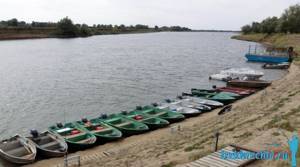
Live bait methods
Pike perch swallow bait from the head more often than from the tail, so the location of the hook is of great importance. There are three main options:
- Behind the dorsal fin.
- Under the gills.
- For the upper lip.
The first method is used using a treble hook. If the fish is hooked correctly, it retains its mobility for a long time, which attracts a predator. Doubles are placed under the gills. This method immediately detects prey if the attack occurs from the head. However, it restricts the fry from moving and when breeding a double, it is important not to damage the gills. Using a single hook, the fish is placed behind the upper lip. It is important to monitor the mobility of the bait, and if you bite or catch a “fanged” one, change it.
The size of the hooks must match the bait fish. Small ones will be difficult to detect fish, and large ones will become noticeable ballast on the body of the fry, which will alert the predator and a bite may not occur.
Fishing with a dead fish using an elastic band
Whole fish caught in a pond or its slices are used as bait, but sprat is considered the best bait. The peculiar aroma attracts pike perch and provokes a bite. They hook a small fish by the back, piercing it through with a hook.
The category of bottom gear also includes elastic. Its design consists of a lead weight that holds the tackle in one place, thick rubber, leashes with hooks and a reel. As a rule, from 7 to 10 hooks are installed on one tackle, which increases the chances of catching pike perch. The elastic band is installed from the shore, along promising points.
Tulka has been used by fishermen for many decades. Particular attention to this bait from the “fanged” one is shown in the cold season. A passive predator takes stationary prey better, because the energy required to catch it is minimal. If you couldn’t get sprat, then bleak, mustard or rudd will do. Before attaching the bait, you should trim the fish a little in the belly area (for a characteristic smell).
Zander bait
Cut “white” fish are a very attractive bait for fanged predators, and they are used universally all year round along with live bait. If there is no better bait as live bait than bleak, then in the form of cut fish, cut sprat is often the most effective, but always the first fresh one . An old sprat sitting in a fish store is unlikely to attract pike perch. Therefore, fishermen try to purchase sprat in fishing stores, although it is much more expensive there than in regular stores.
Cut sprat is very effective in late autumn, when sheer lures with heavy spoons, massive jigs and jig heads with a tail or slice of sprat are used to catch pike perch. Often, for some reason, pike perch and bersh are taken better precisely on the tail of the fish, mounted on the hook of a jig, balancer and spinner. The game of bait with replanting of sprat at this time is not very active and is more reminiscent of fussing and moving a spoon or jig on the bottom.
In winter, cut sprat is also very effectively used for fishing with spoons, balancers and heavy jigs. Quite often, fixed fishing rods or light jigs with cutting bait outperform sports gear that uses spinners or balancers without adding sprat. The equipment of fixed fishing rods is a tandem of jigs, where the lower one is heavy, and the upper one on a short leash is light. Luminous jigs are usually used. The success of such equipment is that the upper jig has a flexible hook suspension. This gives an active game of bait with cutting.
Share with your friends!
Use of feeding mixtures
In some cases, additional measures should be taken to attract the predator. As you know, pike perch stays close to peaceful fish and attracting them to the fishing point increases the chances of catching a “fanged one”. But this is only a theory, but in practice they use compositions of offal, dried blood, fish meal and meat attractants - elements that can cause an appetite in an underwater inhabitant.
The binding part of the feeding mixture is sifted clay or molehill soil. You can also add breadcrumbs. Bloodworms, chopped worms, maggots are an excellent living component of feeding.
The fishing point is fed with balls the size of oranges. For starting feeding, 5-6 pieces are enough, and the rest are added during fishing (every hour). Using the mixture in pike perch fishing is not at all necessary, but if the fish is passive, then a cunning move can provide several trophies.
The success of donka fishing depends primarily on the ability to adapt to capricious fish. Changing the place or bait in time, experimenting with equipment is the treasured key to a good catch.
Source: intellifishing.ru
Lures for zander
Companions. The gravel pit where I fish is stocked with walleye, pike, perch and chub. The last thing you have to worry about is the perches. They do not respond to bait from fish, especially sea fish. Chubs constantly require some variety. Unfortunately, most of these fish fell prey to cormorants, so it’s unlikely you’ll catch anything here today.
Pike respond best to bait, and since we are talking about the largest of them, which gather at the fishing site, it’s a sin to complain. Fortunately, there are no eels in my gravel pit, because they also react very positively to bait from pieces of fish. And you don’t have to ask the pike perch for long. From my experience of feeding pike, I know how important it is to choose the right place.
In deep ditches. I know the structure of the bottom of my gravel pit quite accurately. There I once had to catch pike perch in one ditch almost 100 m wide and about 5 m deep, which was a gulley located between the shore and a large island. In the summer it was heavily overgrown with algae, but from late autumn until spring its bottom remained fairly clean. What kind of baits are these with a “twist” and what kind of fish to catch with them you will learn from this article.
This is where I decided to feed. I didn’t know how the fishing would go, so I made sure to catch at least a pike if there was no pike perch. In the middle of the ditch, about 40 m from each other, I laid two feeding points, to which I managed to throw bait from the shore. I fed one place with pieces of chopped sea fish, and the other with freshwater fish.
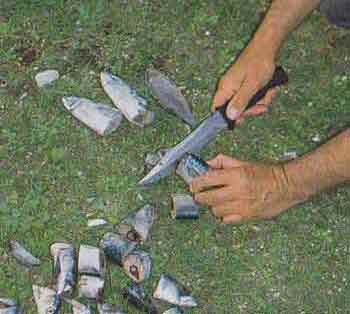
Frozen mackerel and herring cut into pieces
I used pre-thawed fresh frozen fish. From sea fish I took mackerel and herring, and from freshwater fish I took roach and bream - the same forage fish that I bought in the summer for catching pike perch. I threw pieces of fish using a slingshot with a large pocket, which is used in fishing competitions.
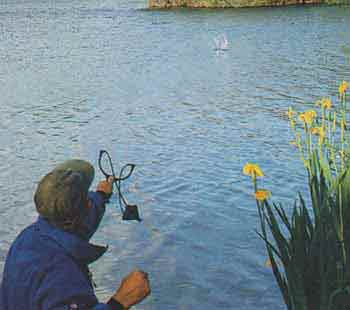
I baited the place with a slingshot
Burbot bait
One of the baits that is attractive to burbot is cut fish . This bait usually takes the largest fish, just like live bait. But sometimes there are difficulties with live bait, especially in early spring and late autumn, when small fish often don’t bite at all. And “cutting” can be done from any fish of the carp family. I remember a friend brought carp bought in the city with him for night fishing, cut it into thin slices and baited it with hooks. And I caught several burbots during the night. But, nevertheless, the nocturnal predator prefers local roaches and especially ruffs, which can be planted either whole, without removing the spines, or cut into slices. Burbot is very fond of these prickly and snotty fish, which have a lively character. It is better to catch burbot for cut fish in the fall. In spring it is better to use large brushes of worms or crawlers.
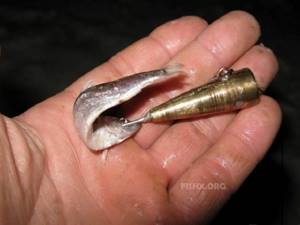
Lures for zander
Feed once a week. In November and December, once a week I shot several kilograms of chopped fish into the lake. As a rule, I fished on this lake only in late autumn, when the water became clear and its temperature dropped. This time I was almost sure of success. However, the question remained open: should we rely only on pike or pike perch would also be willing to take bait at night?
My first fishing trip took place in December. I used simple float and bottom rigs. On some rods, I put small pieces of fish on the tee No. 6, similar to those with which I was feeding. I placed a large piece of fish on one of the tackles in case a pike approached. And all that was left of the mackerel was the tail...
I pierced a piece of fish 15-20 cm long with two tees No. 6 in two places. On the first day there were seven bites - all pike. I was a little disappointed, but as darkness fell another fish landed on my hook. While fishing, I felt from the characteristic twitching that this time I had spotted a pike perch. The spiny dorsal fin and glassy eye shimmered in the beam of light from the headlamp.
The bait was still sticking out of the walleye's mouth: a mackerel tail on two #6 treble hooks. In my entire fishing life, I have only seen a dozen walleye take a saltwater fish. Was this pike perch really attracted to bait? If the fish looked emaciated and exhausted, then I would understand why it attacked such a bait. But this pike perch was in excellent condition.
Before stopping fishing, I threw another 3 kg of sea and freshwater fish into the water, and this time the entire mass in the same place. A few days later, history repeated itself: for the whole day I caught pike, in the evening several hooks went into emptiness, and then I caught another pike perch, again using sea fish - smelt. I also attribute unsuccessful hookings to the machinations of pike perch, because pike are almost always hooked reliably.
Exact feeding time. This pattern was repeated throughout the winter and even into the spring. Over time, more and more pike perch began to gather at the bait point. And finally, the moment came when there were five or six bites during a short evening outing, which was not bad for a lake in which there were not many pike perch. But one thing remained unshakable: the pike perch almost did not change the time it came out to feed.
The first bites occurred in the evening twilight and continued for several hours until nightfall. This way the bite was highly predictable and I was able to enjoy a few short hours of evening fishing. Pieces of fish and several large pike were lured to the fishing spot. There aren’t that many seasoned pike in my gravel pit, but one of them was still tempted by the bait.
It seems that it was she who attacked the smaller pikes and pike perch that I was fishing for. Some pike perch weighing from 1.8 to 2.7 kg had wide marks on their backs - clearly from her teeth. And then one day I caught a 2.7-kilogram pike perch with fresh marks from her attack. The subsequent bite brought me a 12-kilogram pike, which, apparently, had attacked the pike perch shortly before.
Pike eat pike perch. An interesting question arises: do pikes eat walleyes? I have seen this so often that I am convinced of it. When there are not enough small forage fish, pikes turn their attention to pike perch. However, my catches prove that pike perch can be attracted to the fishing spot again after a certain time. It would be interesting to know whether sea fish bait also works in other bodies of water. In any case, I will try to check this on my native rivers and canals and inform readers about it.
Written by Mike Brown
Source: fishcom67.ru
Fishing for pike perch
Fishing with pieces of fish
Pieces of fish
Pieces of fish are good because idle bites are almost completely eliminated. You can cut pieces from roach, although any other white fish will do.
Slice fishing equipment
The bottom equipment should be mounted as follows. We take a fairly powerful spinning rod, which must be equipped with a suitable reel. The sinker for such tackle should be pear-shaped and weigh approximately 20 grams. A single hook No. 4-6, which has a long shank, must be attached to the leash.
The main line is braided, 0.14 mm thick, the leash is monofilament, 0.25 mm thick. The strip of fish (bait) can be rectangular or similar to a triangle. The front should be slightly thicker than the back.
Baiting a slicer on a hook
When setting the bait, you need to pierce the front thickened end of the fish strip twice with a hook. Then you need to put a tiny piece of rubber on the hook so that the bait is fixed. Pike perch and other predators bite on the donk much more often than on other equipment, so this fishing option is several times more effective than the usual fishing with a spinning rod.
Equipment for fishing from the bottom for cutting
Fishing places
First of all, you should fish spits and edges, especially in those places where there are differences in depth, where shallower waters connect with deep ones. Feeding fish prefer to stand in such places, which means there will be a predator there.
Fishing Features
The wiring when fishing with a donk should be as follows: the rod is raised steeply up, while the bait is slightly raised above the bottom, then there is a short pause. And then you need to make a jerk and reel in the line a little. These actions must be performed until the bait appears from the water.
Most of the bites happen while reeling in the reel. After a careful jerk, you should move the spinning rod forward and immediately hook. Before fishing, it’s a good idea to feed the fishing area by cutting the fish into small pieces. The smell of fish will attract predators to the fishing spot.
